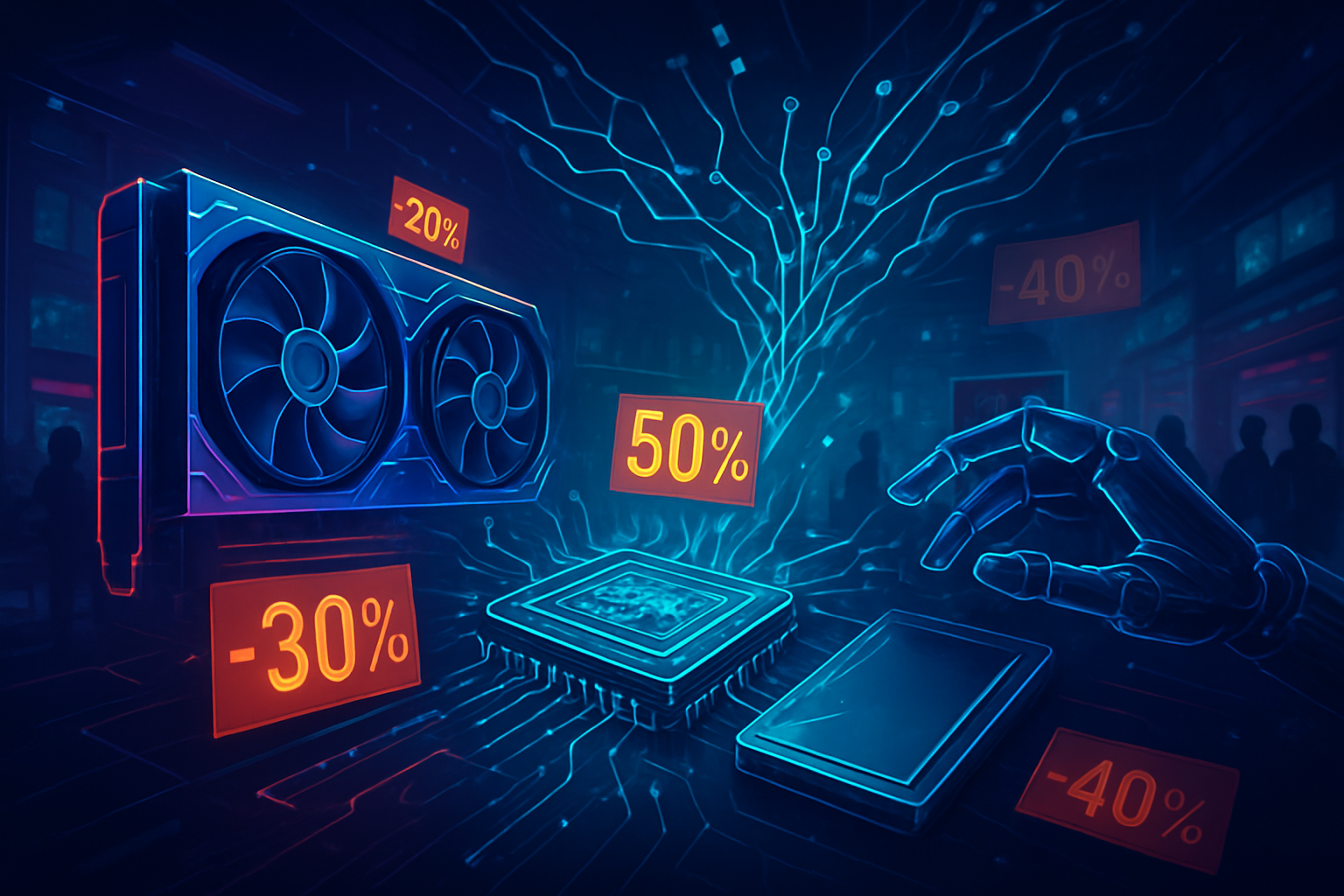In a pivotal moment for global sustainability, recent advancements in industrial technology, spearheaded by Artificial Intelligence (AI), sophisticated automation, and groundbreaking materials science, are revolutionizing resource recovery. These innovations are not merely incremental improvements but represent a paradigm shift, enabling unprecedented rates of material reclamation and setting new benchmarks for efficiency and environmental stewardship. The immediate significance of these breakthroughs lies in their profound capacity to curtail waste, conserve finite natural resources, and significantly reduce the carbon footprint of industrial operations worldwide. As of late 2025, these technologies are moving rapidly from experimental stages to widespread industrial adoption, promising a future where waste is increasingly viewed as a valuable resource, not a liability.
The integration of AI, robotics, and novel material sciences is creating a synergistic effect, transforming the entire lifecycle of resource management. From optimizing complex sorting processes to enabling the chemical breakdown of previously unrecyclable plastics, these developments are crucial enablers of a true circular economy. The implications extend across diverse sectors, including manufacturing, waste management, and even mining, offering a tangible path toward a more sustainable and resource-efficient industrial landscape.
Technical Marvels Redefining Resource Reclamation
The technical core of this revolution lies in the sophisticated deployment of AI and automation. AI-powered optical sorting systems now boast accuracy rates of up to 95% in identifying and separating materials like plastics, metals, paper, and glass from mixed waste streams. These systems leverage high-resolution cameras, advanced sensors, and intricate machine learning algorithms to discern materials based on a multitude of characteristics, including color, shape, texture, and spectral signatures. This level of precision dramatically reduces contamination, thereby elevating the purity and market value of recovered materials—a critical factor in closing the loop for high-quality recycled content.
Beyond sorting, machine learning algorithms are optimizing entire recovery processes. In wastewater treatment, for instance, AI is deployed to fine-tune chemical usage and reduce the energy intensity of processes like aeration, all while maintaining strict compliance and safety standards. Predictive analytics, driven by AI, are also forecasting waste generation trends, allowing for optimized collection routes and schedules that slash fuel consumption, operational costs, and greenhouse gas emissions. A notable advancement is the application of Generative AI in the disassembly of electronic waste, aiding in the design of robotic systems that can efficiently extract valuable components, maximizing resource recovery from complex e-waste streams. Furthermore, AI-powered waste analytics platforms, such as Greyparrot Analyzer and Deepnest, are providing real-time insights into waste composition, bridging critical information gaps between brand owners and waste facility operators to improve packaging design for recyclability.
Complementing AI, robotic sorting systems have become ubiquitous, processing materials up to four times faster than manual methods and operating continuously. These robots, often integrated with AI, not only enhance speed but also significantly reduce labor costs (by up to 40%) and minimize human exposure to hazardous materials. The global waste sorting robot market is projected for substantial growth, reaching approximately USD 1.5 billion in 2025 and expanding to USD 14.7 billion by 2033. In the realm of advanced materials, next-generation membrane filtration technologies are proving transformative for wastewater treatment. Novel membrane materials, incorporating graphene oxide, ceramic composites, and advanced coatings, offer superior durability, higher flux, and lower energy consumption, even with harsh industrial wastewaters. Forward Osmosis (FO) membranes, in particular, are gaining traction for their ability to achieve higher water recovery rates with less energy, selectively recovering valuable solutes. Breakthroughs in chemical recycling, such as Mura Technology's Hydro-PRT® process, utilize supercritical water to convert mixed, post-consumer plastics into circular hydrocarbon products, effectively tackling previously "unrecyclable" materials and offering a viable alternative to incineration and landfill. These technical differentiators mark a significant departure from previous, often less efficient and more labor-intensive, mechanical recycling and waste management approaches, signaling a robust and scalable future for resource recovery.
Reshaping the Competitive Landscape: AI's Influence on Tech Giants and Startups
The surge in resource recovery advancements, powered by AI, automation, and novel materials, is fundamentally reshaping the competitive landscape for AI companies, established tech giants, and agile startups alike. This technological wave is creating distinct beneficiaries, fostering new competitive dynamics, and driving significant market repositioning.
AI companies are at the vanguard, developing the specialized software, computer vision systems, and robotic solutions that are the backbone of modern resource recovery. Firms like AMP Robotics, Recycleye, Greyparrot, and Gongye Technology are direct beneficiaries, providing the AI-powered sorting and identification equipment that can achieve over 90% accuracy in separating diverse materials. These companies are not only improving efficiency but also reducing contamination by up to 40% compared to manual methods. Furthermore, AI platforms for predictive maintenance and data analytics, offered by startups such as Zabble, geoFluxus, and Resourcify, are becoming indispensable for optimizing operational lifespans, streamlining processing strategies, and informing policy decisions in waste management. The ability of AI to track material lifecycles from production to disposal is also fostering unprecedented transparency, crucial for a truly circular economy.
Tech giants, recognizing both the environmental imperative and the strategic advantage, are deeply invested in these advancements. Companies like Apple (NASDAQ: AAPL) are developing sophisticated internal robotics, such as the "Daisy" robot, to meticulously disassemble iPhones and reclaim precious metals, showcasing a commitment to internal circularity and reducing reliance on virgin materials. Similarly, Ikea has adopted AI platforms to manage returned merchandise, drastically reducing waste. Collaborations between giants like Unilever (NYSE: UL) and the Alibaba Group (NYSE: BABA) on AI-enabled plastic packaging recycling systems highlight the cross-industry commitment. Moreover, the increasing demand for critical raw materials (lithium, cobalt, rare earths) for modern technologies has piqued the interest of tech giants in AI-powered urban mining—reclaiming valuable materials from electronic waste. Huawei, for example, is heavily invested in autonomous mining fleets in China for critical minerals. These companies are leveraging AI to meet stringent regulatory demands, enhance their sustainability profiles, and secure resilient supply chains.
The resource recovery sector is also a fertile ground for AI-driven startups, which often focus on niche applications or disruptive approaches. Companies like Trizzy offer AI for waste recognition, while Cycled Technologies AS provides smart bins with personalized recycling profiles. Smarter Sorting uses AI for inventory management to reduce retail waste, and Sorted employs computer vision, spectroscopy, and colored lasers, all driven by AI, to augment human pickers' efficiency. These startups benefit from agile innovation, rapid deployment capabilities, and a continuous flow of venture capital funding—evidenced by companies like Earth AI raising significant Series B funding for AI-driven clean energy metal discovery. This dynamic ecosystem fosters a competitive environment where early adopters gain significant advantages through superior efficiency, cost savings, and enhanced brand reputation, potentially rendering traditional, less efficient waste management methods obsolete or requiring substantial upgrades. The shift also incentivizes "design for circularity," disrupting traditional linear product lifecycles and creating more localized, resilient supply chains for high-quality recycled materials.
A Broader Horizon: AI's Integral Role in a Sustainable Future
The integration of AI, automation, and advanced materials into resource recovery marks a pivotal moment, aligning seamlessly with broader AI trends and offering profound societal and environmental impacts. This development is not an isolated breakthrough but a critical component of the ongoing digital transformation, pushing the boundaries of what's possible in sustainability and efficiency.
These advancements fit squarely within the overarching trends of the Circular Economy and Industrial Symbiosis, where AI acts as a crucial orchestrator, optimizing resource loops and facilitating the exchange of waste and energy between industrial entities. It's an essential pillar of Industry 4.0, emphasizing intelligent, interconnected systems, real-time data analysis, and optimized supply chains for resource management. The success of AI in waste sorting, for instance, is a direct outcome of the dominance of Machine Learning and Computer Vision, particularly deep learning with Convolutional Neural Networks, enabling systems to "see" and "learn" from vast datasets of waste materials with unprecedented accuracy. This trend of using advanced perception and pattern recognition for complex real-world tasks is a hallmark of modern AI. Furthermore, the convergence of AI with IoT sensors and Digital Twin technology is creating smart cities where waste management is dynamically optimized, contributing to sustainable urban planning and data-driven decision-making.
The societal and environmental impacts are far-reaching. Environmentally, these technologies lead to reduced landfilling and resource depletion by significantly increasing recycling rates and the purity of recovered materials, thereby conserving natural resources and lowering energy consumption, greenhouse gas emissions, and water usage associated with virgin material extraction. They accelerate the transition to a circular economy, fostering regenerative systems. Societally, while automation may lead to job transformation in manual sorting roles, it simultaneously creates new "green jobs" in areas such as designing, maintaining, and operating AI and robotic systems, as well as in material recovery and sustainable design. Enhanced worker safety, economic benefits from improved efficiency, and increased consumer engagement through smart recycling solutions are also significant positive outcomes.
However, potential concerns temper the enthusiasm. The high initial investment and the challenge of integrating new systems with often outdated infrastructure pose significant hurdles. The ethical implications of job displacement due to rapid automation necessitate a "just transition" with adequate retraining and social safety nets to prevent exacerbating social inequalities. Critically, the energy consumption and carbon footprint of AI itself—from training complex models to operating energy-intensive data centers—must be addressed, ideally through renewable energy sources, to ensure that the solution doesn't inadvertently contribute to the problem. Concerns also exist regarding the e-waste generated by AI hardware and the potential for intensified resource extraction if AI optimization in industries like mining is not carefully regulated. Data quality, bias, and the "black box" nature of some AI models also present challenges to transparency and equitable outcomes.
Comparing these developments to previous AI milestones reveals a significant leap. Earlier automated systems relied on basic mechanical separation with limited precision. The current generation of AI-powered robots, leveraging advanced computer vision and deep learning, can classify waste materials with over 95% purity based on complex characteristics—a stark contrast to the rudimentary automation of the past. The key breakthrough lies in the learning and adaptability of modern AI systems, which can continuously refine their algorithms from vast datasets. This moves resource recovery from a reactive, labor-intensive process to a proactively optimized, intelligent, and adaptive system, representing a paradigm shift akin to the impact of AI on fields like medical diagnostics or autonomous driving.
The Road Ahead: Pioneering a Circular Future with AI
The trajectory of AI, automation, and advanced materials in resource recovery points towards a future where waste is systematically eliminated, and resources are kept in continuous circulation. Both near-term and long-term developments promise a profound transformation of industrial ecosystems and urban environments.
In the near term (next 1-5 years), we can expect the widespread adoption of AI-powered computer vision and robotic sorting systems in Material Recovery Facilities (MRFs), achieving unprecedented sorting accuracy (often exceeding 95-99% purity) and efficiency. This will significantly reduce contamination and elevate the value of recovered materials, potentially cutting sorting expenses by 60%. Automated waste characterization, driven by AI, will provide critical data for optimizing collection and processing strategies. Predictive maintenance, powered by machine learning, will become standard, minimizing downtime and extending machinery lifespans. Furthermore, AI combined with IoT sensors in waste bins will enable dynamic route optimization for collection vehicles, slashing fuel consumption and emissions by up to 30%. The rise of collaborative robots (cobots) in MRFs will also enhance worker safety and operational efficiency, with the global cobot market projected to expand at a CAGR of 37.4% from 2021 to 2028.
Looking further into the long term (beyond 5 years), AI is poised to facilitate ubiquitous closed-loop systems where recovered materials are seamlessly reintegrated into manufacturing, drastically reducing reliance on virgin resources. Enhanced urban mining, powered by AI, will improve the recovery of valuable materials from existing infrastructure, landfills, and complex waste streams. AI will also optimize advanced recycling technologies, such as chemical recycling for plastics, enabling them to process diverse and challenging waste streams. We anticipate the emergence of fully autonomous waste processing plants and robotic arms capable of highly precise material separation with minimal human intervention. Automation will extend to the deconstruction of complex products, while AI-powered waste management systems will integrate seamlessly with broader smart city infrastructures, coordinating with transportation and energy systems for holistic urban sustainability. The development of low-cost, portable, AI-powered robotic material recovery plants could even enable efficient waste management in remote areas or for specialized tasks like marine waste clean-up.
Potential applications on the horizon are vast, spanning beyond MRFs to electronic waste (e-waste) processing, where adaptive robotic systems will automate complex disassembly; construction and demolition (C&D) waste, where AI and robotics will sort complex streams for reuse; and food waste management, with AI monitoring production and consumption to minimize spoilage and optimize valorization. In the mining industry, AI will optimize mineral exploration, streamline extraction, and enhance real-time monitoring. Crucially, AI will drive supply chain optimization and design for circularity, using generative design algorithms to create products inherently easier to repair, disassemble, and recycle, supported by "material passports" that track materials throughout a product's lifecycle.
Despite this promising outlook, significant challenges remain. High initial investment, ensuring data quality and preventing algorithmic bias, and the complexity of integrating new AI systems with outdated infrastructure are critical hurdles. The energy consumption and carbon footprint of AI itself must be managed through sustainable AI development. The social implications of job displacement require proactive workforce transition programs, while the "black box" problem of some AI models demands greater transparency. Experts, however, remain largely optimistic, predicting AI to be an indispensable tool for advancing the circular economy, revolutionizing waste management by 2025, and driving significant market growth in robotics and critical material recovery. The convergence of AI with IoT and blockchain is expected to further enhance the capabilities and transparency of future material recovery systems.
A New Chapter in AI and Sustainability: The Resource Recovery Revolution
The current wave of advancements in industrial technology for resource recovery, driven by AI, automation, and advanced materials, represents a monumental stride towards a sustainable future. The key takeaways underscore AI's transformative power in achieving exceptional recovery rates, enhancing material purity, and driving significant cost and energy savings across diverse industries. AI-powered sorting, predictive maintenance, and optimized logistics are not just improving existing processes but fundamentally reshaping how we perceive and manage resources.
In the annals of AI history, this development stands as a critical milestone, showcasing AI's profound ability to move beyond digital optimization to address tangible, real-world environmental challenges. It signifies a maturation of AI from niche applications to an indispensable tool for global sustainability, demonstrating its capacity to orchestrate complex industrial ecosystems towards a circular economy. This is a "game-changer" for industries historically reliant on manual labor and outdated infrastructure, marking a shift from rudimentary automation to intelligent, adaptive, and learning systems.
The long-term impact is poised to be profoundly positive, decoupling economic growth from resource depletion and environmental degradation. By making resource utilization more efficient, economically viable, and scalable, AI will accelerate the transition to a truly circular economy, leading to significantly less landfill waste, conserved natural resources, and reduced greenhouse gas emissions. However, realizing this potential demands a concerted effort to address the inherent challenges, particularly the energy consumption and e-waste generated by AI itself. The future calls for "greener AI" and sustainable digital infrastructure to ensure that AI's environmental benefits ultimately outweigh its own footprint.
In the coming weeks and months, watch for continued advancements in AI-powered sorting algorithms and sensors, targeting even more complex materials. Expect an increased integration of IoT and real-time data analytics for intelligent waste collection and transparent material flow tracking. Crucially, keep an eye on evolving regulatory frameworks and policy support, such as the EU's Digital Product Passport, which will further incentivize AI's role in circular supply chains. Finally, anticipate a growing number of cross-industry collaborations and investments, along with a heightened focus on Green AI initiatives, as the world moves decisively towards a regenerative, resource-efficient future powered by artificial intelligence.
This content is intended for informational purposes only and represents analysis of current AI developments.
TokenRing AI delivers enterprise-grade solutions for multi-agent AI workflow orchestration, AI-powered development tools, and seamless remote collaboration platforms.
For more information, visit https://www.tokenring.ai/.









